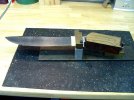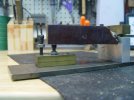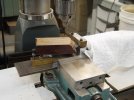Am thinking about my next knife to make and would like to have a tapered tang. I know you would drill the pin holes before tapering, but after the taper how do you get the handle pin holes straight? I have been thinking and thinking on this and cant figure it out. Thank you in advance for your answers.
-
The BladeForums.com 2024 Traditional Knife is ready to order! See this thread for details: https://www.bladeforums.com/threads/bladeforums-2024-traditional-knife.2003187/
Price is$300$250 ea (shipped within CONUS). If you live outside the US, I will contact you after your order for extra shipping charges.
Order here: https://www.bladeforums.com/help/2024-traditional/ - Order as many as you like, we have plenty.
You are using an out of date browser. It may not display this or other websites correctly.
You should upgrade or use an alternative browser.
You should upgrade or use an alternative browser.
Q on drilling handles straight pin holes on tapered tang
- Thread starter MT Borg
- Start date
- Joined
- Dec 3, 1999
- Messages
- 9,437
You HAVE to have a flat and parallel surface to clamp the blade by when you drill the holes for the handle scales. Anyone who tells you that you don't, does not understand simple physics.
I built a fixture for it.

But I use it for other operations, so it was worth the time/effort to make it.



The quick/easy thing to do is clamp a piece of square tubing to your drill press table, then clamp the blade to that (with the scales clamped to the blade).
I built a fixture for it.

But I use it for other operations, so it was worth the time/effort to make it.



The quick/easy thing to do is clamp a piece of square tubing to your drill press table, then clamp the blade to that (with the scales clamped to the blade).
- Joined
- Jan 13, 2006
- Messages
- 84
My process:
Step -1: Make sure the table under your drill chuck is true to the chuck
Step 0: Make sure both the tang side and outside planes of the scales are parallel
Step 1: Drill the holes in the tang
Step 2: Clamp tang to first scale, drill first hole with scale on table, drop pin in hole to maintain alignment
Step 3: Drill other holes
Step 4: Lay second scale on table. Align tang and first scale over second scale. Use pins to maintain alignment between first scale and tang in holes you're not drilling
Step 5: Using existing holes in first scale, use them as guides to drill holes in second scale, again using pins to maintain alignment
Harder to explain than to do.
Step -1: Make sure the table under your drill chuck is true to the chuck
Step 0: Make sure both the tang side and outside planes of the scales are parallel
Step 1: Drill the holes in the tang
Step 2: Clamp tang to first scale, drill first hole with scale on table, drop pin in hole to maintain alignment
Step 3: Drill other holes
Step 4: Lay second scale on table. Align tang and first scale over second scale. Use pins to maintain alignment between first scale and tang in holes you're not drilling
Step 5: Using existing holes in first scale, use them as guides to drill holes in second scale, again using pins to maintain alignment
Harder to explain than to do.
- Joined
- Nov 8, 2009
- Messages
- 1,533
I wonder why they make the drill table tilt when no one ever uses it...I glue or tape builders shims to the underside of the scales and use the grinder or disk sander to adjust these as close as possible, if I am being picky. Another trick is to get as close as you can by whatever method, drill a size under, and ream the whole thing through in one shot afterwards, but you have to have a carbide reamer to do this with a hardened tang.
- Joined
- Jul 13, 2009
- Messages
- 21,255
You HAVE to have a flat and parallel surface to clamp the blade by when you drill the holes for the handle scales. Anyone who tells you that you don't, does not understand simple physics.
I built a fixture for it.
But I use it for other operations, so it was worth the time/effort to make it.
The quick/easy thing to do is clamp a piece of square tubing to your drill press table, then clamp the blade to that (with the scales clamped to the blade).
So this goes back to your ricasso area being surface ground perfectly flat and parallel ?
- Joined
- Apr 2, 2011
- Messages
- 425
What if you drill your holes prior to tapering , like in How to Make Knives by Bob Loveless ? Then fit the rough shaped handles to the blade and drill one side , stick whatever fastener your using or a drill bit in that hole , drill the second hole and then repeat the process with your other slab? I've seen a tutorial on the angle and all that on why you should drill it differently but if it all fits up with your fasteners/slabs and blade + epoxy then isn't that good.
- Joined
- Dec 3, 1999
- Messages
- 9,437
Duffy, I'd have to go back and look at the book to see exactly what they did, it's been a long time since I read it. I have the Loveless video, and they use a whole lot of fixtures in order to get the knife fit together.
Here's my take on this situation----
You profile the blade and drill the holes through the tang while the stock is flat.
Then you go to the grinder and taper the tang and heat-treat the blade.
Now you need to fit the scales. IF you lay a flat/parallel scale on the drill press table and then lay the (now tapered) tang on the scale, the holes in the tang ARE NOT IN LINE WITH THE SPINDLE ANYMORE. Capitalized for emphasis.
Maybe a guy can fudge this by using something with liners and colored epoxy, but do it with a tapered tang that has surface ground flats, lapped ivory scales, NO LINERS, and YOU WILL HAVE ISSUES.
The reason no one ever tilts the drill press table is because it's too much of a PITA to get it back to perfectly square to the spindle compared to using a simple fixture and never having to mess with the table.

Another reason it's worth having a SIMPLE fixture like that one I have, is for drilling stag or ivory scales that are only flat on the inside (tang) surface. People can argue about whether you can lay the scale on the table with a tapered tang (even though they're wrong :foot but there is no way in hell you can lay a piece of textured stag on your drill press table and get it to lay flat. No way.
but there is no way in hell you can lay a piece of textured stag on your drill press table and get it to lay flat. No way. 
Here's my take on this situation----
You profile the blade and drill the holes through the tang while the stock is flat.
Then you go to the grinder and taper the tang and heat-treat the blade.
Now you need to fit the scales. IF you lay a flat/parallel scale on the drill press table and then lay the (now tapered) tang on the scale, the holes in the tang ARE NOT IN LINE WITH THE SPINDLE ANYMORE. Capitalized for emphasis.
Maybe a guy can fudge this by using something with liners and colored epoxy, but do it with a tapered tang that has surface ground flats, lapped ivory scales, NO LINERS, and YOU WILL HAVE ISSUES.
The reason no one ever tilts the drill press table is because it's too much of a PITA to get it back to perfectly square to the spindle compared to using a simple fixture and never having to mess with the table.
Another reason it's worth having a SIMPLE fixture like that one I have, is for drilling stag or ivory scales that are only flat on the inside (tang) surface. People can argue about whether you can lay the scale on the table with a tapered tang (even though they're wrong :foot
Okay, i just did 3 tapered tangs and this is how I did it. I thought i found the process on here but maybe not:
1. profile blade and drill pin holes before tapering tang.
2. taper tang.
3. grind blade, heat treat, sand etc, (in other words, get it ready for scales).
4. Measure the blade thickness at the ricasso and at the end of the tang (with micrometer or capliper, to 0.001".
5. subtract the end thickness from the ricasso thickness and divide by 2.
6. place a drill bit this diameter under the scale near the end of the knive like a shim and drill your holes as normal.
Example: 0.125" at ricasso, 0.065" at end of tang; diff is 0.060", 1/2 of that is 0.030, Number 68 drill is 0.031" use that as your "shim"
i'm not even sure I understand what I just typed, so let me know if this makes sense. This only works for scales that are flat and Parallel, not bone or stag, etc.
randy
1. profile blade and drill pin holes before tapering tang.
2. taper tang.
3. grind blade, heat treat, sand etc, (in other words, get it ready for scales).
4. Measure the blade thickness at the ricasso and at the end of the tang (with micrometer or capliper, to 0.001".
5. subtract the end thickness from the ricasso thickness and divide by 2.
6. place a drill bit this diameter under the scale near the end of the knive like a shim and drill your holes as normal.
Example: 0.125" at ricasso, 0.065" at end of tang; diff is 0.060", 1/2 of that is 0.030, Number 68 drill is 0.031" use that as your "shim"
i'm not even sure I understand what I just typed, so let me know if this makes sense. This only works for scales that are flat and Parallel, not bone or stag, etc.
randy
Last edited:
- Joined
- Apr 14, 2011
- Messages
- 168
I'm getting ready to try tapering a tang on my next blade... seems to me that drilling the tang and scale materials prior to tapering would be the easiest way to go about it. Unless I'm misunderstanding, that appears to be the consensus thus far. I'm looking forward to seeing everyone's input -- thanks for bringing this up!
- Joined
- Jul 13, 2009
- Messages
- 21,255
I'm getting ready to try tapering a tang on my next blade... seems to me that drilling the tang and scale materials prior to tapering would be the easiest way to go about it.
I don't think that will work for you.
You would end up with
______/______________/
________________________
______\______________\
The holes through the blade would be perpendicular, but the holes through the handle material would be cocked back towards the butt.
Last edited:
- Joined
- May 23, 2008
- Messages
- 954
I am just finishing my first 3 tapered tang knives; I made a fixture similar to Nicks using 1-2-3 blocks. I drilled my tang hole prior to tapering so that they are square.
The Loveless shop drills each scale with the scale and tang held flat on a work rest thus ending up with a hole that is not straight similar to 1-10's diagram. This works with the real Loveless bolts. It would not work with knock-off bolts. The real bolts are conical in shape on the tang side and in conjunction with the angled holes work together to pull the scales towards the guard.
David Sharp
Sharpwerks
The Loveless shop drills each scale with the scale and tang held flat on a work rest thus ending up with a hole that is not straight similar to 1-10's diagram. This works with the real Loveless bolts. It would not work with knock-off bolts. The real bolts are conical in shape on the tang side and in conjunction with the angled holes work together to pull the scales towards the guard.
David Sharp
Sharpwerks
- Joined
- Dec 3, 1999
- Messages
- 9,437
nevermind 
I do it by spot glueing the slab on the tang with a few tiny drops of super glue, clamping the blade in a drill press vise using the ricasso as a flat to go by. I then slide a wood wedge under the grip between the table and the grip. Just barely snug. Then drill and repeat for the other. I move the wedge very near each hole for support. The slabs come off easily with a rap on my wood topped work bench. My holes are drilled in the tang before tapering. Comes out as perfect as one can get every time.
I've been wondering about how to do this. I've never tapered a tang, heck I've only been making knives for a few months! This thread really helped me understand how to drill a tapered tang. I know I'm not contributing any information, but I wanted to thank everyone who did!
Thank you all for the great information, I can see there are several ways to skin this cat.
Am thinking a small round bubble level could be set on the flat ricasso or extra handle material, put in a vice and drilled. I like the jig that Nick has, Randy's description/process and how LRB does it. Thank you everyone.
Am thinking a small round bubble level could be set on the flat ricasso or extra handle material, put in a vice and drilled. I like the jig that Nick has, Randy's description/process and how LRB does it. Thank you everyone.
Like LRB, i use 2 drops of superglue to fix the scales to the tang before drilling the holes. I like Nick's jig a lot but I don't weld and haven't gotten around to building one yet. As long as you drill the tang holes a little oversize, and SOMEHOW account for the taper in the tang, you'll be fine.
The way I do it, it is square to the holes in the tang, and the taper is accounted for. The taper is acually of no concern as long as the ricasso is reasonably true to the blade in general. My table is square to the chuck, the vise is square to the table, and my tapers are true to the blades ricasso, which started as square stock. One would would have put negative effort into the process to screw it up. I started doing tapered tangs in around 1984. I have never encountered a problem with hole alignment using this method, but maybe I have just been lucky a few hundred times. I did learn the hard way though, to place the drops of super glue down the center of the tang. If you don't, especially with wood, some of your grip may get left behind where you might need it, when you break the glue loose, and then you have a prob.
- Joined
- Dec 3, 1999
- Messages
- 9,437
I wanted to follow up on this because I finally found my Loveless book in one of the moving boxes.
Bob shows their shop technique for this and they use a fixture to hold the blade so that that holes will be in line with the drill spindle.
There is a section in the second half of the book called "alternate methods" that shows another maker (name is escaping me right this minute) that just lays the handle material on the drill press, but he's also gluing the scale down and they stress that everything was made flat/square/etc.
Bob shows their shop technique for this and they use a fixture to hold the blade so that that holes will be in line with the drill spindle.
There is a section in the second half of the book called "alternate methods" that shows another maker (name is escaping me right this minute) that just lays the handle material on the drill press, but he's also gluing the scale down and they stress that everything was made flat/square/etc.
